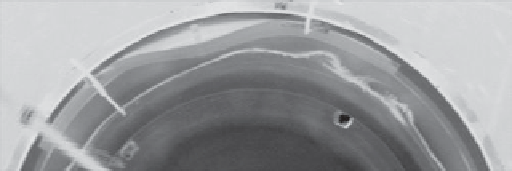Geoscience Reference
In-Depth Information
(a)
(b)
(c)
(d)
(e)
(f)
Figure 12.3.
Snapshots from reference experiment at (a)
t
= 0 s, (b)
t
=17s,(c)
t
=29s,(d)
t
=45s,(e)
t
= 66 s, and (f)
t
= 104 s.
until
t
= 29s, at which point the dye is aligned radially.
By
t
= 45s the wave has oversteepened and broken, and
the position of the dye line is a double-valued function of
azimuth. Thereafter, as the vorticity in the oversteepened
wave envelope is removed by bottom friction, it gradually
unwinds in the mean flow, forming an undulating wave
train by
t
= 66s. Eventually both sides of this wave
train curl up on themselves, as shown at
t
= 104s. In the
following sections we will interpret this behavior using an
adaptation of nonlinear shelf wave theory to the annulus
and using numerical simulations of the barotropic QG
shallow-water equations.
speed. The QG equations are derived thereafter by pos-
ing an asymptotic expansion for a small Rossby number,
Ro =
U/fL
1, where
U
and
L
are characteristic horizon-
talvelocityandlengthscales,respectively.Variationsof the
bottom topography
h/H
are also assumed to be
(
Ro
)
.
For the configuration shown in Figure 12.1 we define
the horizontal length scale as
L
=
R
c
−
O
R
w
and the velocity
scale as
U
=
2
f
R
h
,so
L
= 31.5cm and
U
≈
1.4cm
/
s.
These scales yield an aspect ratio of
H/L
≈
0.6 and a
Rossby number of Ro
0.03, while the variations of the
bottom topography are characterized by
H
s
/H
= 0.25.
While these quantities are all smaller than 1, they are
large enough to call QG theory into question. In prac-
tice, however, the rotation of the tank is sufficiently strong
that the fluid adheres closely to columnar motion due to
the Taylor-Proudman effect.
Williams et al.
[2010] showed
that QG theory may provide qualitatively accurate results
for rapidly rotating flows that lie far outside its formal
regime of validity.
≈
12.3. QUASI-GEOSTROPHIC MODEL
EQUATIONS
We model the flow in our annular channel using the
shallow-waterQGequations[
Pedlosky
,1987;
Vallis
,2006].
The single-layer shallow-water equations describe the
evolution of a homogeneous layer of fluid under the
assumption that the flow is restricted to columnar motion
and confined beneath a rigid lid at its upper surface. This
assumption is consistent with a small ratio of vertical
to horizontal length scales,
H/L
12.3.1. Interior Dynamics
Under the assumptions of shallow-water QG theory,
the conservation of horizontal fluid momentum in our
annular channel may be expressed in the form
1, and appropriate
for motions much slower than the surface gravity wave





















